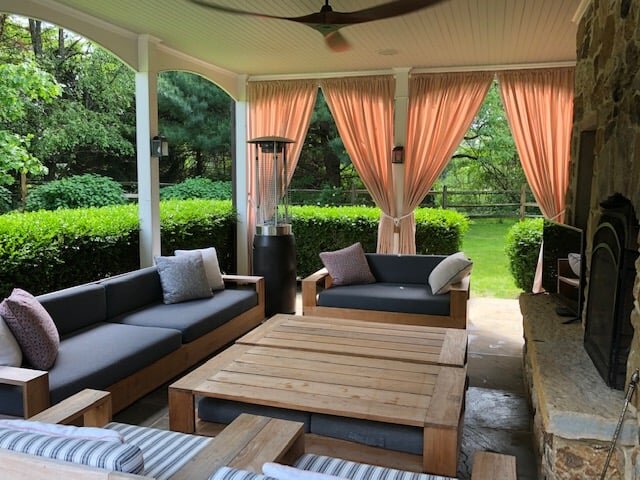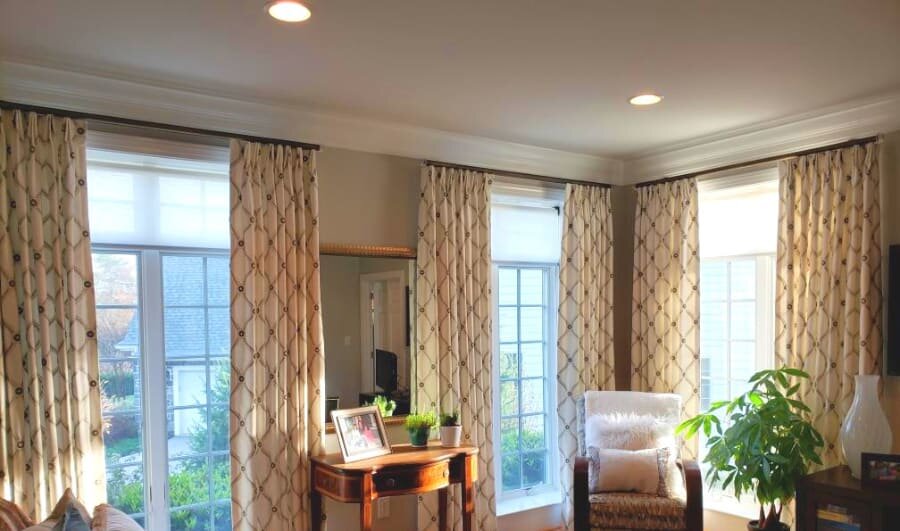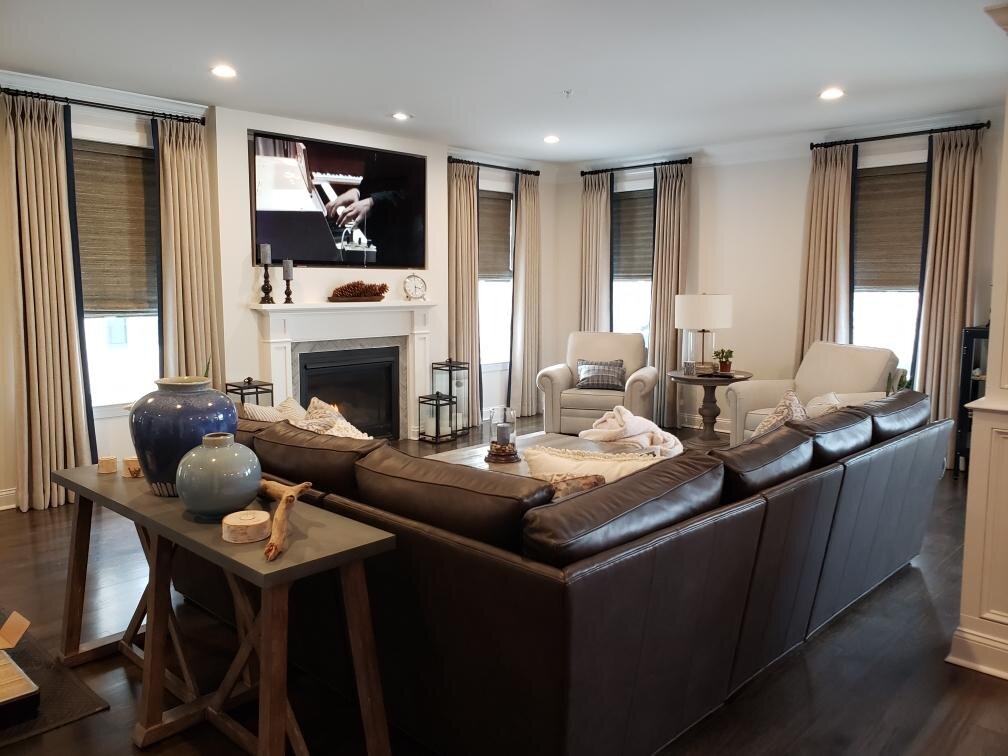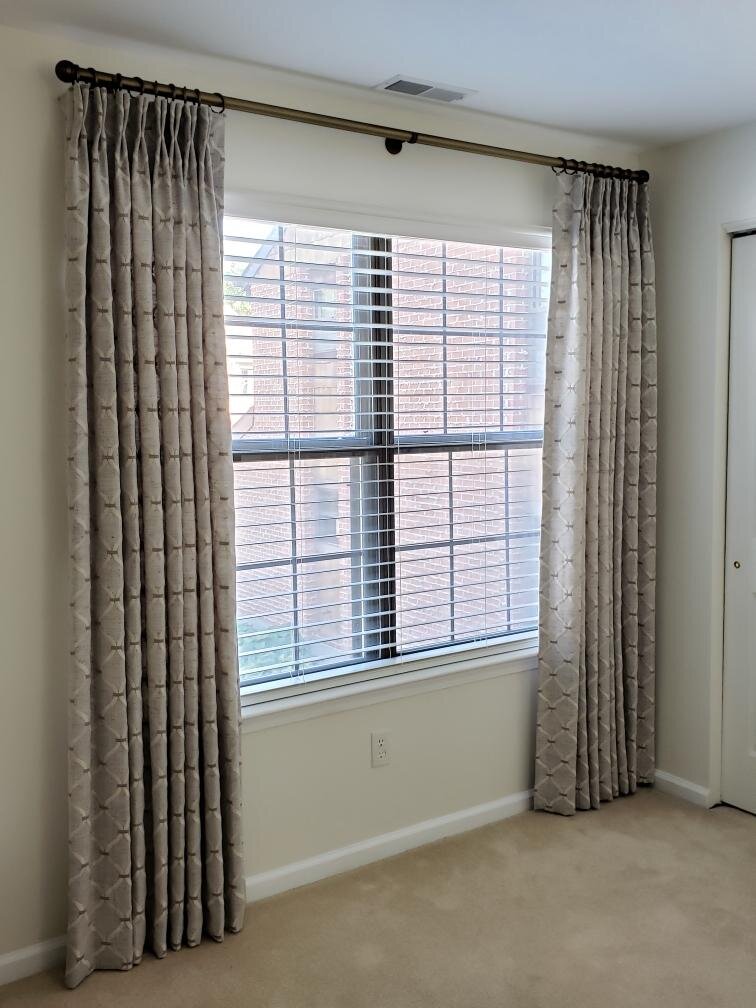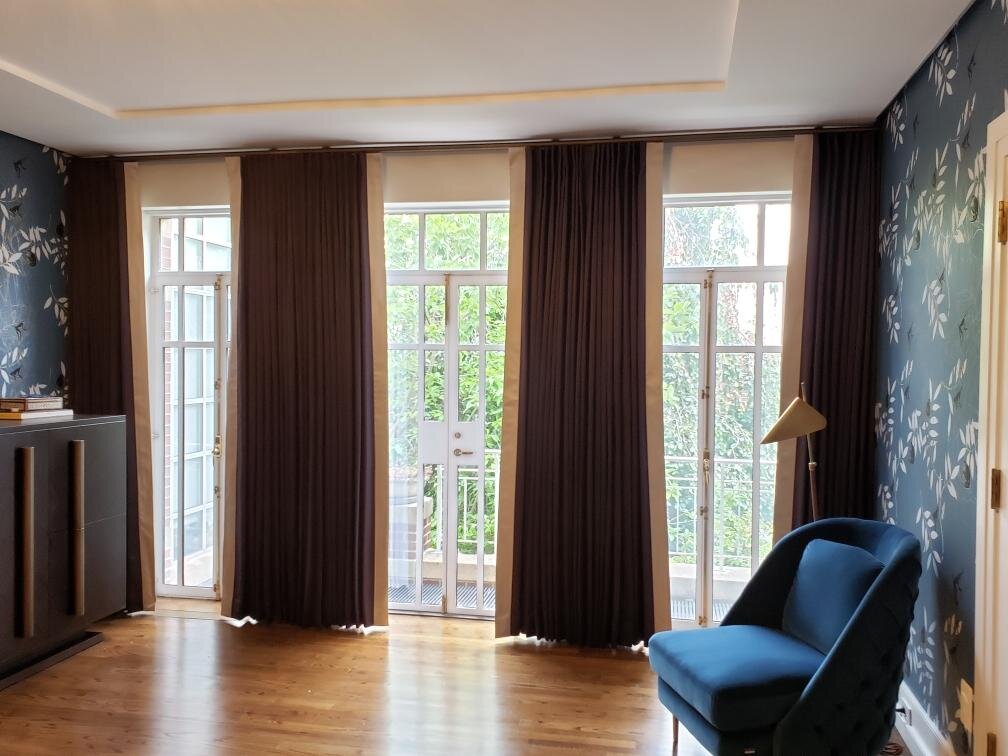Curtains that are perfect for your home both aesthetically and functionally are more important than you might first think. Both aspects are necessary for a treatment to be successful within your home. So, take time to explore not only the look of new window coverings but also the modern design options, state-of-the-art features, and functional versatility of the different styles of soft, fabric-based window treatments before choosing your next curtains, drapes, or side panels.
Our team would love to help you pick the perfect curtains and draperies!
Comparing Curtains, Drapery, and Side Panels
When it comes to fabric shades, often curtains, drapery, and side panels are used interchangeably in casual conversation, which is understandable as they share so many features. However, there are differences between the styles that prove important when selecting new window coverings so understanding the nuances of each style is a key step in finding the perfect curtains, drapes, or side panels for your home.
Curtains, drapery, and side panels all consist of long panels of fabric that are hung from a rod installed along the top of the window frame (or higher in some cases). Ergo, aesthetically they share a flowing open feel as their installation secures only the top of the fabric allowing the sides and bottom to remain free. The main differences between curtains, drapes, and side panels are seen in their length and movement.
Drapery
Drapes are a rich and dramatic window treatment that uses often heavier or lined fabrics to create window fashions that are equal parts eye-catching style and light-controlling functionality. Drapery is, at a minimum, the full length of a window, but more commonly in modern design drapery is run floor-length or from the floor to the ceiling for luxurious looks that can read formal or fun depending on fabric choice. Drapes are also a great choice to use in layered window fashions as their styles and the side-to-side operational system is compatible with shutters, blinds, Roman shades, woven wood shades, roller shades, and sheer shadings.
Curtains
Usually shorter than full drapery, curtains are close in size to the actual dimensions of the window often extending only a few inches over the window frame. Curtains are also more commonly made from lighter fabrics or sheer materials which are ideal for rooms like the dining room or home office where natural illumination is highly beneficial. Café curtains are another popular style of home curtain that is installed over the lower half of a window; café curtains are favored in rooms like the bathroom or kitchen because they provide privacy but don’t block light.
Side Panels
Side panels can be almost any length, long like drapery or shorter like curtains, and of almost any material from translucent sheers to opaque tweeds. The biggest difference between side panels and curtains or drapes is that side panels are stationary; they do not open in a side-to-side manner. Instead, side panels are designed to frame a window hanging to the left and right sides of the window to draw the eye and showcase the view.
Benefits of Curtains and Drapery
As a window treatment, there are numerous benefits to curtains, drapes, and side panels. The fabric-forward styles of soft window treatment affect interior design because of their prominent visual placement in many key rooms of the home. The benefits they afford homeowners, therefore, are both singularly focused on the individual treatment and culminating when looking at using curtains, drapery, or side panels throughout a home. Curtains, drapes, and side panels also provide both decorative and functional advantages since they fulfill both beautifying and practical roles.
A Tool for Design
Curtains, drapes, and side panels are powerful tools for design because they are visually prominent and highly customizable. Curtains, drapes, and side panels are available in a wide range of fabrics from soft sheers to textural linens to natural kinds of cotton to luxurious silks with prints, patterns, and solids to choose from. The Hunter Douglas Design Studio® suite of products also pulls from exclusive designer lines like the Atwood collection, an 8-print line of exclusive, hand-crafted prints from renowned textile artist Rebecca Atwood. With smart fabric use, curtain, drapes, and side panels can be styled to be focal points of design in the room (especially when using bold prints or colors) or act as neutral backdrops to ground design and showcase other features (often when fabrics in neutral tones are used). With numerous fabric styles to choose from, customizing curtains, drapes, or side panels to match existing décor is a breeze whether the intended use is as a focal point or neutral backdrop.
Curtains, drapery, and side panels can also affect the physical feel of a room. Not only do they help draw the eye to the window and thus outside, which helps imbue an open and airy feel to the space, but with the strategic use of different patterns and installation styles, the illusion of length or height can also be added. For example, vertical stripes on curtains or drapery elongate the treatments as does hanging drapery from floor to ceiling to give the illusion of taller windows on a proportionally larger wall. Conversely, entire walls covered in rich drapery create an enveloping and cozy feel within the interior space. So, when customizing curtains, drapery, or side panels for your home ask yourself both how you want the curtain to look in the room and how you want the room to feel when the window treatments are installed.
Create a Peaceful Indoor Environment
In addition to being an aesthetic tool to create stylish and personal décor, another benefit of curtains and full drapery is their ability to create peaceful home environments. The fabric folds of curtains and especially heavy or lined drapery muffle sound, block light and increase privacy. Curtains and drapery both dampen outdoor noise for quieter interiors and help to improve the acoustics of the room itself reducing echo and reverberations. In the same way, they deflect sound waves, curtains and drapes can also be used to filter or block light rays. When lined with room darkening fabrics, curtains and drapes are especially attuned to light control and useful in rooms that necessitate darkness for peace like the bedroom at night or a media room during the day. Curtains and drapes also afford a greater and more complete sense of privacy that can be easily adjusted throughout the day to respond to changing demands of the room. Thus, a room that looks amazing feels comfortable, and is enjoyable to use throughout the day and night is created with the help of curtains and/or drapery.
Better Energy Efficiency
Look good, feel good, and save money. It’s the trifecta of homeowner bliss and it is what you can expect with Hunter Douglas curtains and drapery. Uncovered windows are portals for unwanted energy exchange between the inside of your home and the brutal natural elements outside. Drapes and curtains add a layer of insulation to ease energy transfer, which makes maintaining a comfortable indoor atmosphere easier. Less artificial energy is needed to cool or warm the home when less is left to escape out open windows, and so curtains and drapery add to a home’s energy efficiency which saves homeowners real money every month.
Accessorizing with Curtains and Drapery
Curtains, drapery, and side panels can all be utilized as solo window treatments, or they can be equally as successful when incorporated into layered looks or styled with coordinating accessories. The Hunter Douglas Design Studio® line of curtains, drapery, and side panels gives homeowners the power to create individualized treatments that not only match but enhance décor.
Layered Window Fashions
Drapery is one of the most common top treatments in layered window fashions because its overarching style is strong enough to front a multi-dimensional treatment and its structural design works with most sub-layer treatments styles including shutters, blinds, Roman shades, roller shades, sheer shadings, woven wood shades, and honeycomb shades.
Matching Accessories
Purchase extra yardage when buying new curtains, drapes, or side panels to create custom matching accessories. Coordinating fabrics help to tie a room together with a classic tone and root design aesthetics throughout the space to enhance its effect. Custom accessories can include decorative pillows; upholstered chairs, ottomans, poufs, and/or sofas; bedding; and fabric valances.
Valances
A stylish topper for curtains, drapery, and side panels is a custom fabric valance. Valances polish the final look of curtains, drapery, and side panels by offering a graceful way to hide hardware. Valances can also be used as design highlights to add pattern or color to a window treatment or soften an overall look depending on how valances are constructed, and the types of fabric used.
Hunter Douglas Design Studio®
The Hunter Douglas Design Studio® houses a fantastic line of high-end curtains, drapery, and side panels. The elite line of window treatments utilizes the best materials and the latest operational designs for treatments that are fashion-forward and reliable for years of hassle-free use. Curtains, drapery, and side panels from the Design Studio® collection also come with a variety of customizable features for aesthetic and functional enhancements.
Customizable Features
Fabric: With one of the largest fabric collections for window treatments in the industry, Hunter Douglas curtains, drapes, and side panels pull from fabrics in a wide assortment of colors, patterns, opacities, and materials. The Design Studio® also houses exclusive designer lines including Rebecca Atwood’s 8-print fabric collection.
Pleat Style: Pleats can change the look of a drape and affect how the fabric hangs. With the Design Studio®, a pleat style is a customizable option that includes pinch pleats, classic 2-finger style, European 2-finger style, ripple-folds, or grommets.
Liners: Many kinds of curtains and drapery are available with light-filtering or light-blocking liners that help the treatment better control light or create blackout interiors to a greater degree.
Hardware: Fashion-forward treatments are hung from equally dynamic sets of hardware in the Design Studio® collection. Choose from different styles and finishes for curtain rods, brackets, end caps, and side hooks.
Operating System: Hunter Douglas drapery is available with manual operating systems or motorized systems. PowerView® Automation makes it easy for homeowners to control their motorized shades from a smartphone or tablet, hand-held remote, convenient wall panel, or through voice command when integrated into a home-assistant or smart-home program.
Learn more about custom curtains, drapery, and side panels from the window treatment experts at Window Concepts for Drapery. Request a consultation or stop by their location near Paoli, Pennsylvania, to talk about curtains, drapes, side panels, or custom fabric valances for your home. Window Concepts for Drapery serves residents in southeastern Pennsylvania including the areas of Malvern, Chester Springs, Gladwyne, Radner, Berwyn, and Paoli, PA.
